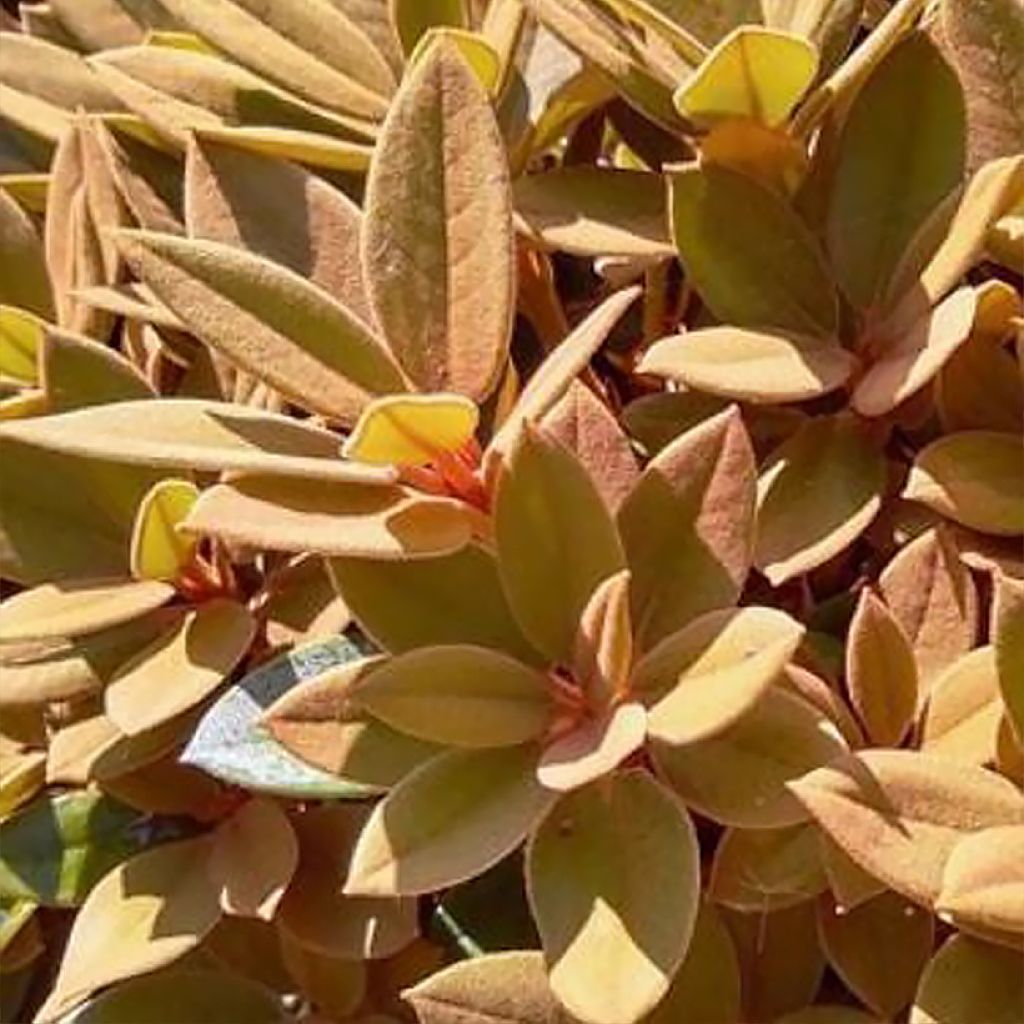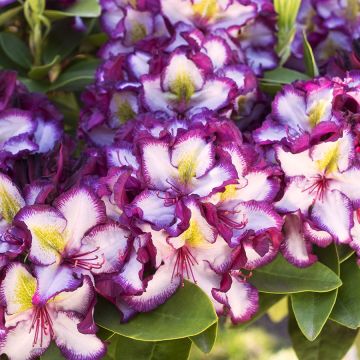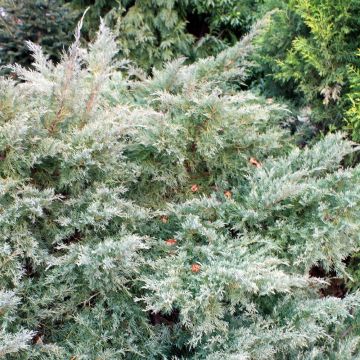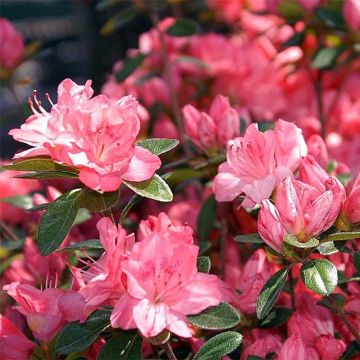

Rhododendron Easydendron INKARHO Rusty Dane
Rhododendron Easydendron INKARHO Rusty Dane
Rhododendron x hybrida Easydendron® INKARHO® Rusty Dane
This item cannot be shipped to the selected country
Delivery charge from €5.90
More information
Schedule delivery date,
and select date in basket
This plant carries a 24 months recovery warranty
More information
We guarantee the quality of our plants for a full growing cycle, and will replace at our expense any plant that fails to recover under normal climatic and planting conditions.
From €5.90 for pickup delivery and €6.90 for home delivery
Express home delivery from €8.90.
Does this plant fit my garden?
Set up your Plantfit profile →
Description
Rhododendron Easydendron® Inkharo® Rusty Dane is a variety with a compact habit, whose foliage takes on a bronze or rusty hue when it emerges, before gradually turning dark green. In May, this small Rhododendron produces a beautiful white flowering, which contrasts pleasantly against the dark vegetation. Forming a bush as wide as it is tall, with evergreen leaves, its compactness allows it to be grown in a container on a terrace. In a diverse bed, on the edge of trees, Rusty Dane can do without acidic soil and be planted in more varied soils, even slightly chalky or somewhat heavy ones.
Rhododendrons are plants from the Ericaceae family, just like heathers, Gaultherias or Kalmias (Mountain Laurels). The history of Inkharo Rhododendrons, somewhat revolutionary plants, began in Germany over 20 years ago. The discovery of a Rhododendron naturally growing in a chalk quarry made it possible to consider grafting different varieties onto its extraordinary root system. The bushes obtained by this method tolerate a wide range of soils with a pH ranging from 4.5 to 6.5, as long as they are loose, fertile, moist, and not excessively chalky.
Rusty Dane is a hybrid obtained by cross-breeding Rhododendron bureavii, a small Chinese species from the Yunnan mountains, whose foliage is covered in a rusty-coloured down, and Rhododendron pachysanthum, from Taiwan, slightly taller but just as hairy on both sides of the leaves. Rusty Dane also has a chalky down, ranging in colour from bronze to rusty, on the young foliage, which gradually fades as the leaves grow. They are dark green with a very regular elliptical shape, pointed at the end, and are of medium size, about 6 to 9 cm long. When the young shoots appear, the bush has a two-tone appearance, with the juvenile leaves standing out against the dark green background.
With slow growth, this compact Rhododendron reaches a height of 60 to 75 cm after ten years of cultivation and an equivalent width. This compactness, combined with its tolerance for different soils, allows it to fit well in most gardens. In May, it forms pink flower buds that open into medium-sized white trumpets (6-8 cm). The white corollas are formed by five petals fused at the base, which then open outward, presenting a rounded tip. The upper petal is speckled with reddish-pink spots, while a cluster of stamens with a brown end emerges from the heart of the flower, accompanied by a protruding pistil, with a raised yellow tip.
The Rusty Dane Rhododendron is a very hardy plant, down to -20°C, at least. It is relatively tolerant in terms of exposure, we recommend planting it in non-scorching sun or partial shade, if possible in the east, where it benefits from the morning sun while being protected from excessive heat. Create a year-round flower bed by combining it with Camellias: Camellia sasanqua and its varieties will reward you with their white, pink, or red flowers in autumn and winter, while Camellia japonica will enchant the beginning of the year or spring. Skimmia japonica Godries Dwarf takes over in April-May with its clusters of small white-pink flowers. From June to October, you can count on Hydrangea macrophylla Rosita, a Hydrangea with large, bright pink heads, which will bring joy to your scene.
Report an error about the product description
Plant habit
Flowering
Foliage
Botanical data
Rhododendron
x hybrida
Easydendron® INKARHO® Rusty Dane
Ericaceae
Cultivar or hybrid
Other Inkarho Rhododendrons
Planting and care
Plant Rhododendron Inkarho Rusty Dane in a semi-shaded position, protected from cold and drying winds, in moist, loose, fertile soil. The soil should be slightly alkaline, neutral, or acidic, which is suitable for hydrangeas. Dig a hole three times larger than the pot. Soak the root ball in water and plant the bush at the collar level in a nutrient-rich mix of leaf compost, gravel or pumice, and loam or topsoil, as Inkarho Rhododendrons are hungry plants. Water generously and keep the soil moist in summer. Azaleas and Rhododendrons have a relatively shallow root system, so they are susceptible to long periods of drought. Therefore, it is recommended to enrich the soil with humus and provide abundant watering during dry periods. Apply a layer of wood chips or mulch around the base of the bush every spring to maintain soil moisture and slightly acidic pH. Maintenance involves removing faded flowers after flowering and pruning dead branches.
Azaleas and Rhododendrons can sometimes be attacked by weevils, which eat the leaf edges and rootlets, as well as the famous "rhododendron beetle," which usually does not cause significant damage. There are effective natural solutions against weevils. Yellowing of the leaves (chlorosis) in Rhododendron indicates poor assimilation of iron in the soil and can lead to premature death of the plant. While limestone is usually the cause, poorly drained soil or deeply planted root ball can also explain the phenomenon.
Planting period
Intended location
Care
This item has not been reviewed yet - be the first to leave a review about it.
Evergreen shrubs
Haven't found what you were looking for?
Hardiness is the lowest winter temperature a plant can endure without suffering serious damage or even dying. However, hardiness is affected by location (a sheltered area, such as a patio), protection (winter cover) and soil type (hardiness is improved by well-drained soil).

Photo Sharing Terms & Conditions
In order to encourage gardeners to interact and share their experiences, Promesse de fleurs offers various media enabling content to be uploaded onto its Site - in particular via the ‘Photo sharing’ module.
The User agrees to refrain from:
- Posting any content that is illegal, prejudicial, insulting, racist, inciteful to hatred, revisionist, contrary to public decency, that infringes on privacy or on the privacy rights of third parties, in particular the publicity rights of persons and goods, intellectual property rights, or the right to privacy.
- Submitting content on behalf of a third party;
- Impersonate the identity of a third party and/or publish any personal information about a third party;
In general, the User undertakes to refrain from any unethical behaviour.
All Content (in particular text, comments, files, images, photos, videos, creative works, etc.), which may be subject to property or intellectual property rights, image or other private rights, shall remain the property of the User, subject to the limited rights granted by the terms of the licence granted by Promesse de fleurs as stated below. Users are at liberty to publish or not to publish such Content on the Site, notably via the ‘Photo Sharing’ facility, and accept that this Content shall be made public and freely accessible, notably on the Internet.
Users further acknowledge, undertake to have ,and guarantee that they hold all necessary rights and permissions to publish such material on the Site, in particular with regard to the legislation in force pertaining to any privacy, property, intellectual property, image, or contractual rights, or rights of any other nature. By publishing such Content on the Site, Users acknowledge accepting full liability as publishers of the Content within the meaning of the law, and grant Promesse de fleurs, free of charge, an inclusive, worldwide licence for the said Content for the entire duration of its publication, including all reproduction, representation, up/downloading, displaying, performing, transmission, and storage rights.
Users also grant permission for their name to be linked to the Content and accept that this link may not always be made available.
By engaging in posting material, Users consent to their Content becoming automatically accessible on the Internet, in particular on other sites and/or blogs and/or web pages of the Promesse de fleurs site, including in particular social pages and the Promesse de fleurs catalogue.
Users may secure the removal of entrusted content free of charge by issuing a simple request via our contact form.
The flowering period indicated on our website applies to countries and regions located in USDA zone 8 (France, the United Kingdom, Ireland, the Netherlands, etc.)
It will vary according to where you live:
- In zones 9 to 10 (Italy, Spain, Greece, etc.), flowering will occur about 2 to 4 weeks earlier.
- In zones 6 to 7 (Germany, Poland, Slovenia, and lower mountainous regions), flowering will be delayed by 2 to 3 weeks.
- In zone 5 (Central Europe, Scandinavia), blooming will be delayed by 3 to 5 weeks.
In temperate climates, pruning of spring-flowering shrubs (forsythia, spireas, etc.) should be done just after flowering.
Pruning of summer-flowering shrubs (Indian Lilac, Perovskia, etc.) can be done in winter or spring.
In cold regions as well as with frost-sensitive plants, avoid pruning too early when severe frosts may still occur.
The planting period indicated on our website applies to countries and regions located in USDA zone 8 (France, United Kingdom, Ireland, Netherlands).
It will vary according to where you live:
- In Mediterranean zones (Marseille, Madrid, Milan, etc.), autumn and winter are the best planting periods.
- In continental zones (Strasbourg, Munich, Vienna, etc.), delay planting by 2 to 3 weeks in spring and bring it forward by 2 to 4 weeks in autumn.
- In mountainous regions (the Alps, Pyrenees, Carpathians, etc.), it is best to plant in late spring (May-June) or late summer (August-September).
The harvesting period indicated on our website applies to countries and regions in USDA zone 8 (France, England, Ireland, the Netherlands).
In colder areas (Scandinavia, Poland, Austria...) fruit and vegetable harvests are likely to be delayed by 3-4 weeks.
In warmer areas (Italy, Spain, Greece, etc.), harvesting will probably take place earlier, depending on weather conditions.
The sowing periods indicated on our website apply to countries and regions within USDA Zone 8 (France, UK, Ireland, Netherlands).
In colder areas (Scandinavia, Poland, Austria...), delay any outdoor sowing by 3-4 weeks, or sow under glass.
In warmer climes (Italy, Spain, Greece, etc.), bring outdoor sowing forward by a few weeks.























































